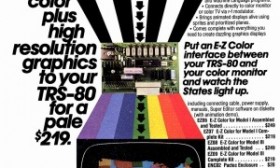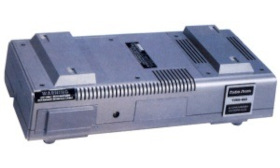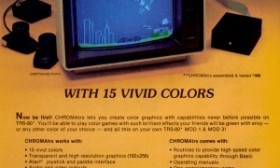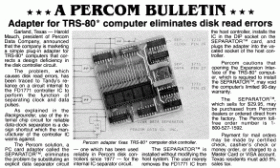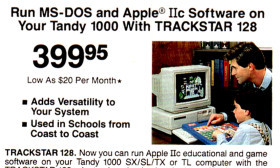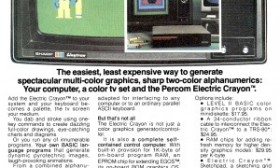The Cassette Gazette was a 1983 one issue advertising newsletter that was a joint production of Lemons Tech and KWIK Software. The Gazette described the products sold by the two companies, mixed in with operational advice and interesting facts about using cassettes with your TRS-80. It appears to have been written by Wayne Lemons, the founder of Lemons Tech. The Gazette is reproduced here page by page with permission from Wayne Lemons’ family.
(Read more...)
The Cassette Gazette was a 1983 one issue advertising newsletter that was a joint production of Lemons Tech and KWIK Software. The Gazette described the products sold by the two companies, mixed in with operational advice and interesting facts about using cassettes with your TRS-80. It appears to have been written by Wayne Lemons, the founder of Lemons Tech. The Gazette is reproduced here page by page with permission from Wayne Lemons’ family.
(Read more...)
The Cassette Gazette was a 1983 one issue advertising newsletter that was a joint production of Lemons Tech and KWIK Software. The Gazette described the products sold by the two companies, mixed in with operational advice and interesting facts about using cassettes with your TRS-80. It appears to have been written by Wayne Lemons, the founder of Lemons Tech. The Gazette is reproduced here page by page with permission from Wayne Lemons’ family.
(Read more...)
Micromint sold several products for the TRS-80 that were based on designs that Steve Ciarcia had presented in his Ciarcia’s Circuit Cellar column in Byte magazine. The Micromint E-Z Color was a color graphics interface for the TRS-80 Model I and Model III that was based on his August 1982 column. In addition to the TRS-80 version, there were also versions of the E-Z Color sold for the S-100 bus and the Apple II.
The TRS-80 version was available in two configurations:
(Read more...)
The Radio Shack TRS-80 Model I had few options for internal expansion other than adding a maximum of 16K of internal memory. The external expansion possibilities were reserved for a device Radio Shack called the Expansion Interface.
The Radio Shack Expansion Interface plugged into the back of the Model I using a six-inch long cable and was designed to serve as a base for the TRS-80 monitor. It provided:
(Read more...)
Probably the most popular of the TRS-80 Model I and III color add-ons was the CHROMAtrs, introduced by South Shore Computer Concepts starting in 1982. It was available in several configurations:
- a kit without case or power supply cost $99.00
- a kit with case and power supply cost $129.00
- a fully-assembled and tested unit cost $169.00
Each CHROMAtrs unit supported both the Model I or Model III and would work with either computer using the proper cable. The Model III cable would also work with the Lobo MAX-80 with a few minor modifications.
(Read more...)
The Radio Shack Expansion Interface added single-density floppy disk support to the TRS-80 Model I. Floppy disks were a great improvement over cassettes. But many people reported problems with reliability, particularly when reading or writing lower disk tracks. CRC errors and locked out tracks occurred with disturbing regularity.
The Separator, sold by Percom for $29.95, fixed all of those problems. It provided a data separator with far higher resolution (16 MHz) than the separator used by the Expansion Interface (1 MHz). Good data separation was vital for isolating the clock and data pulses that made up a disk track.
(Read more...)
After Radio Shack introduced their MS-DOS compatible Model 1000 series, there were persistent rumors about a Model 4 emulation card that was being developed. Such a board would have been an clever way to help migrate Model 4 customers to the newer MS-DOS computers. Some people were even told at their Radio Shack stores that a Model 4 emulator would be released soon. But it never happened and no type of TRS-80 emulator was ever released by Radio Shack.
At the time, Radio Shack sold the Trackstar 128, an Apple IIc emulator card created by Diamond Computer Systems. The Trackstar used actual Apple II ROMs (licensed from Apple) along with custom hardware to achieve nearly 100% Apple compatibility. So the concept of a Model 4 emulation card certainly must have occurred to people at Radio Shack.
I’ve had three different people write to me (years apart) recalling details of a Model 4 emulation project that Radio Shack worked on but pulled at a very late stage. Their accounts match in almost all the details.
(Read more...)
Back in the late 1970’s, the Apple II and the TRS-80 Model I were fierce competitors for computer sales. One advantage the Apple II had over the Model I was the ability to display color graphics. One of the first Model I productsto address this deficiency was the Percom Electric Crayon. Percom introduced the Electric Crayon in December 1979 for a base price of $249.00. It was featured on the cover of the January 1981 issue of 80 Microcomputing.
The Electric Crayon was a small (12 inch wide by 9 inch deep) box which output a composite video signal that could drive either a monitor or a television set. It connected directly to the TRS-80 printer port and was controlled using EGOS, a ROM-based operating system. EGOS was directly programmed using single character commands. Virtually unique among TRS-80 color add-ons, the Electric Crayon did not use the TMS9918 graphics chip and did not support sprites.
(Read more...)
“S-80” was a non-trademarked synonym for for the trademark “TRS-80.” It was usually used to refer to the TRS-80 expansion bus (“S-80 bus”), but sometimes it was used as an all-encompassing term for the TRS-80 and compatibles (“S-80 computers”). Other notable uses include the newsletters S-80 Bulletin (originally TRS-80 Bulletin) and S-80 Computing (originally TRS-80 Computing) and the magazine Softside: S-80 Edition.
One definition of the term appeared in the March/April 1980 issue of 80-U.S. Journal:
(Read more...)

